SAINT SEBASTIAN (Martyr 304 AD)
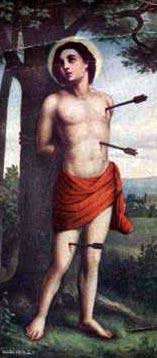
St. Sebastian was born at Narbonne, in Gaul, but his parents were of Milan, in Italy, and he was brought up in that city. He was a fervent servant of Christ, and though his natural inclinations gave him an aversion to a military life, yet to be better able, without suspicion, to assist the confessors and martyrs in their sufferings, he went to Rome and entered the army under the emperor Carinus about the year 283.
It happened that the martyrs, Marcus and Marcellianus, under sentence of death, appeared in danger of being shaken in their faith by the tears of their friends: Sebastian-seeing this, steps in and made them a long exhortation to constancy, which he delivered with the holy fire that strongly affected all his hearers.
Zoe, the wife of Nicostratus, having for six years lost the use of speech by a palsy in her tongue, fell at his feet, and spoke distinctly; by the saint making the sign of the cross on her mouth. She, with her husband Nicostratus, who was master of the rolls, the parents of Marcus and Marcellianus, the jailer Claudius, and sixteen other prisoners, were converted; and Nicostratus, who had charge of the prisoners, took them to his own house, where Polycarp, a holy priest, instructed and baptized them.
Chromatius, governor of Rome, being informed of this, and that Tranquillinus, the father of Saints Marcus and Marcellianus, had been cured of the gout by receiving baptism, desired to be instructed in the faith, being himself grievously afflicted with the same distemper. Accordingly, having sent for Sebastian, he was cured by him, and baptized with his son Tiburtius. He then enlarged the converted prisoners, made his slaves free, and resigned his prefectship.
Chromatius, with the emperor's consent, retired into the country in Campania, taking many new converts along with him. It was a contest of zeal, out of a mutual desire of martyrdom, between St. Sebastian and the priest Polycarp, which of them should accompany this troop, to complete their instruction, and which should remain in the city to encourage and assist the martyrs, which latter was the more dangerous province.
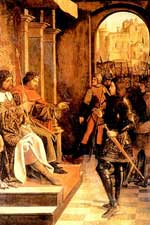 St. Sebastian appears before the Emperors Diocletian and Maximian Hercules in Rome. |
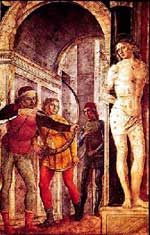 St. Sebastian is handed over to the archers who wound him with arrows. |
St. Austin wished to see such contests of charity amongst the ministers of the church. Pope Caius, who was appealed to, judged it most proper that Sebastian should stay in Rome as a defender of the church. In the year 286, the persecution growing hot, the pope and others concealed themselves in the imperial palace, as a place of the greatest safety, in the apartments of one Castulus, a Christian officer of the court.
St. Zoe was first apprehended, praying at St. Peter's tomb on the feast of the apostles. She was stifled with smoke, being hung by the heels over a fire. Tranquillinus, ashamed to be less courageous than a woman, went to pray at the tomb of St. Paul, and was seized by the populace and stoned to death. Nicostratus, Claudius, Castorius, and Victorinus were taken, and, after having been thrice tortured, were thrown into the sea. Tiburtius, betrayed by a false brother, was beheaded. Castulus, accused by the same wretch, was thrice put on the rack, and afterwards buried alive. Marcus and Marcellianus were nailed by the feet to a post, and having remained in that torment twenty-four hours, were shot to death by arrows. St. Sebastian, having sent so many martyrs to heaven before him, was himself impeached before the Emperor Diocletian, who, having grievously reproached him with ingratitude, delivered him over to certain archers of Mauritania, to be shot to death. His body was covered with arrows, and he left for dead.
Irene, the widow of St. Castulus, going to bury him, found him still alive, and took him to her lodgings, where, by care, he recovered of his wounds, but refused to fly, and even placed himself one day by a staircase where the emperor was to pass, whom he first accosted, reproaching him for his unjust cruelties against the Christians.
This freedom of speech, and from a person, too, whom he supposed to have been dead, greatly astonished the emperor; but, recovering from his surprise, he gave orders for his being seized and beat to death with cudgels, and his body thrown into the common sewer.
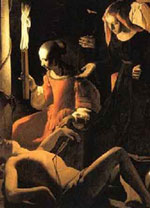 He survives and is nursed in the prison by the pious women. |
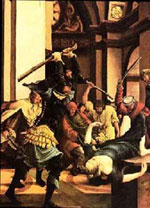 He finally receives the martyrs' crown after being clubbed to death. |
A pious lady, called Lucina, admonished by the martyr in a vision, got it privately removed, and buried it in the catacombs at the entrance of the cemetery of Calixtus. A church was afterwards built over his relics by Pope Damasus, which is one of the seven ancient stationary churches at Rome. Saint Sebastian was venerated at Milan as early as the time of Saint Ambrose and was buried on the Appian Way. He is patron of archers, athletes, and soldiers, and is appealed to for protection against plagues.
Saint Sebastian is the patron saint of athletes because of his physical endurance and his energetic way of spreading and defending the Catholic Faith. Saint Sebastian is also patron to all soldiers. He entered the Roman Army under Emperor Carinus in 283 in order to defend the confessors and martyrs of his day without drawing attention to himself. His efforts kept the faith of Marcus and Marcellian firm during their persecutions, right up to the time of their martyrdom. He was declared the patron of plague sufferers of his reported cures of those afflicted with many diseases.
St. Sebastian has been always honoured by the church as one of her most illustrious martyrs. We read in Paul the deacon in what manner, in the year 680, Rome was freed from a raging pestilence by the patronage of this saint. Milan in 1575, Lisbon in 1599, and other places, have experienced in like calamities the effects of his intercession with God in their behalf.




